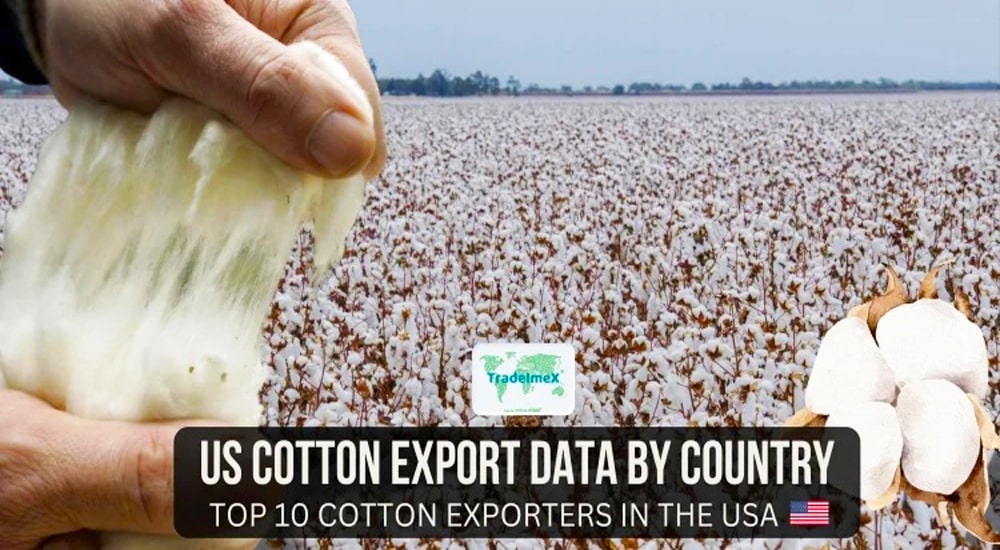
The United States has long been a dominant player in the global cotton trade. Its highly efficient agricultural industry, vast production areas, and advanced technology make it a critical supplier of cotton worldwide. US cotton export data highlights the significant contributions of the country to global textile markets, showcasing its role in meeting the demands of both developing and developed nations.
This blog delves into the United States’ cotton export trends, key destinations, and profiles the top 10 cotton exporters from the country.
The Importance of US Cotton in the Global Market
Cotton is a versatile and essential raw material for the textile and apparel industry. It is particularly prized for its quality and usability, with US cotton being globally recognized for its high grade and reliability. Notably, the USA ranks among the world’s top cotton producers and exporters. By exporting to regions such as Asia, Europe, and the Middle East, the US supplies the raw materials needed for manufacturing various products, from basic clothing to industrial fabrics.
One reason US cotton maintains such high demand is its consistent supply and adherence to international quality standards, often outpacing competitors in areas like environmental sustainability and advanced farming practices.
Trends in US Cotton Exports
According to recent shipment data, the United States has experienced steady growth in its cotton export activities. US Export data reveals some key trends:
1. Strong demand from Asia: The majority of US cotton exports are destined for Asia, where countries such as China, India, and Vietnam play significant roles in textile manufacturing.
2. Growth in Africa and the Middle East: Emerging textile markets in Africa and the Middle East are increasing their US cotton imports, signaling broader diversification.
3. Sustainability-focused buyers: With rising consumer preferences for sustainable textiles, buyers prioritize cotton grown using environmentally friendly practices. The USA’s commitment to sustainable agriculture works as a competitive advantage.
4. Premium products: Many exporters now emphasize exporting higher-grade cotton, catering to premium textile markets worldwide.
Top Countries Importing US Cotton
The US cotton export data by country illustrates the diverse reach of American cotton:
- China: The largest importer of US cotton, China uses the commodity extensively for its vast textile and apparel industries. Despite fluctuating trade relations, China remains a key market.
- Vietnam: Another dominant importer, Vietnam, is heavily reliant on US cotton to sustain its role as a textile manufacturing hub.
- India: As one of the world’s largest producers and processors of cotton, India supplements its domestic supply with imports from the USA.
- Turkey: With its robust textile production industry, Turkey is a significant importer of US cotton for both domestic and export use.
- Pakistan: Known for its global presence in the cotton textile sector, Pakistan imports large quantities of American cotton to meet manufacturing demands.
- Indonesia: Indonesia’s reliance on imported cotton makes the US a vital partner in fulfilling its textile production needs.
- Bangladesh: As a leading global exporter of readymade garments, Bangladesh sources much of its cotton from US exporters.
- South Korea: With its highly developed textiles industry, South Korea is an important trading partner for US cotton suppliers.
- Thailand: The country’s expanding textile industry increasingly imports American cotton due to its quality and consistency.
- Japan: Though smaller in volume compared to others, Japan’s demand for high-grade cotton for premium textiles ensures continued imports from the US.
Top 10 Cotton Exporters in the USA
Below is a profile of the leading US cotton exporters that dominate global markets:
- Cargill Cotton Cargill is a major player in the global cotton industry, combining advanced trading practices with efficient supply chain management. Their extensive network allows them to export large volumes of cotton to numerous countries.
- Louis Dreyfus Company (LDC) Renowned for its robust logistics and sourcing capabilities, LDC specializes in the trade of raw cotton, ensuring a consistent presence in Asia, Europe, and beyond.
- Olam Agri Olam stands out for its sustainable sourcing and focus on quality, catering to the rising demand for environmentally responsible cotton products worldwide.
- Ecom Agroindustrial Corp. Ecom emphasizes sustainable cotton sourcing, working closely with farmers to ensure fair trade practices and exports meeting stringent global standards.
- Staplcotn As a grower-owned cooperative, Staplcotn provides a direct connection to American cotton farms, ensuring high-quality exports backed by farm-to-market transparency.
- Dunavant Enterprises Dunavant has been a leading name in US cotton exports for decades, leveraging its expertise in logistics and market analysis.
- Glencore Agriculture Part of the multinational commodity trading giant, Glencore’s agricultural division exports vast quantities of US cotton through efficient global operations.
- Noble Cotton Known for its deep expertise in commodity trading, Noble Cotton supplies American cotton to international markets with a focus on reliability and consistency.
- Plains Cotton Cooperative Association (PCCA) PCCA has long been one of the largest exporters of US cotton, emphasizing innovation and sustainability.
- Allenberg Cotton Specializing in premium-grade cotton exports, Allenberg maintains strong relationships with international buyers, ensuring American cotton reaches diverse markets efficiently.
The Role of Shipment Data in Understanding US Cotton Exports
Analyzing US cotton shipment data is critical for understanding the nuances of this vital industry. Export records provide valuable insights into key markets, emerging trends, and shifts in buyer behavior. Whether tracking the impact of global events on cotton demand or evaluating competition from other cotton-exporting nations, the data offers a comprehensive view of the supply chain.
Key Factors Impacting US Cotton Exports
Several factors influence the flow of US cotton exports:
1. Trade Policies: Tariffs, trade agreements, and international disputes can impact export volumes.
2. Weather Conditions: Climate and environmental changes significantly affect cotton production yields.
3. Global Demand: Fluctuations in the textile and fashion industries drive cotton import demand.
4. Technological Advances: Precision agriculture and biotechnology have allowed US cotton farmers to optimize productivity.
5. Sustainability Goals: Increased focus on environmentally friendly farming can shape demand from eco-conscious markets.
Conclusion
The US cotton export data by country provides invaluable insights into America’s significant contribution to the global textile market. With major buyers spread across Asia, Europe, and beyond, the US has positioned itself as an indispensable supplier of high-quality cotton. Moreover, the top cotton exporters in the USA ensure a steady and reliable flow of this essential commodity, maintaining strong trade relations worldwide.
In a fast-changing global economy, the ability to adapt to market shifts, prioritize sustainability, and ensure quality will determine the continued success of US cotton exporters. For buyers, researchers, and industry stakeholders, keeping track of export trends through shipment and customs data remains crucial for informed decision-making.





